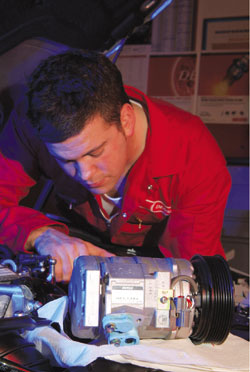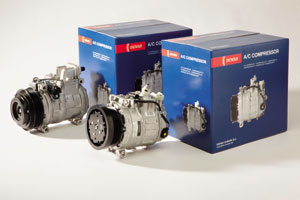
Maintenance and repair of automotive air-conditioning (A/C) units, either manually or automatically controlled, represent a real expansion opportunity for garages and workshops.
 In-depth technical knowledge of A/C systems, common faults, recommended components and oils are all essential to achieve customer satisfaction and build return business.
In-depth technical knowledge of A/C systems, common faults, recommended components and oils are all essential to achieve customer satisfaction and build return business.
OE pedigree
Central to this technical know-how is a comprehensive knowledge of compressors. This is because 99.9% of all compressor problems are not related to product failure, but from a limited understanding of A/C system operation, maintenance and repair.
A strong OE background and decades of research and development, means that DENSO is uniquely placed to offer expert, practical advice on A/C compressor replacement and servicing. We actively support customers through a series of training initiatives in selected regions to inform and train garages on car A/C service, compressor installation and repair procedures.
A key part of this support includes the inclusion of a compressor installation guide, which is attached to every DENSO compressor sold.
Seven essential A/C checks you should be carrying out
As well as checking that the A/C system is properly filled with the correct amount and type of refrigerant and oil, workshops must make several other regular checks:
1. CHECK the pressure and temperature of the exhaust before and after the compressor.
2. CHECK the temperature of the cables from the compressor and the condenser. High pressure should be hot and dry.
3. CHECK the cleanliness of the condenser and radiator fan. The appearance of moisture or frost on the high pressure side could mean a blockage in the flow of refrigerant.
4. CHECK the temperature difference before and after the dryer. A difference of more than 3°C indicates too much moisture.
5. CHECK the refrigerant flow – ice on any element of the air conditioning system is due to a blockage.
6. CHECK the tension and condition of the compressor belt.
7. CHECK for any unusual noises from the compressor, expansion valve, fans, blowers and air-conditioning ducts.










